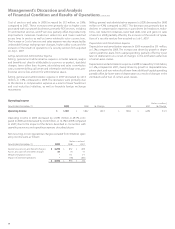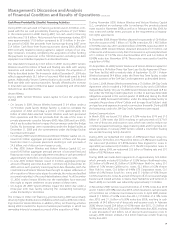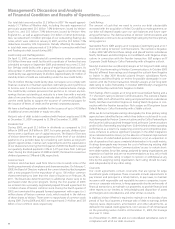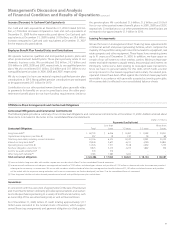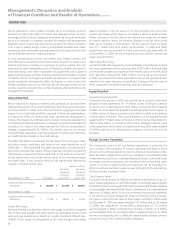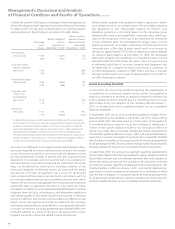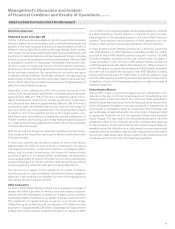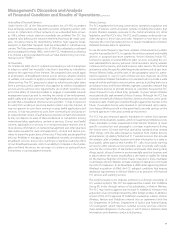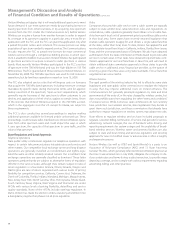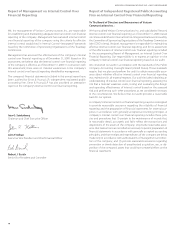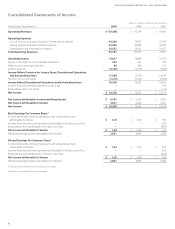Verizon Wireless 2009 Annual Report Download - page 38
Download and view the complete annual report
Please find page 38 of the 2009 Verizon Wireless annual report below. You can navigate through the pages in the report by either clicking on the pages listed below, or by using the keyword search tool below to find specific information within the annual report.
36
Video
The FCC has a body of rules that apply to cable operators under Title VI of
the Communications Act of 1934, and these rules also generally apply to
telephone companies that provide cable services over their networks. In
addition, the Act generally requires companies that provide cable service
over a cable system to obtain a local cable franchise, and the FCC has
adopted rules that interpret and implement this requirement.
Interstate Access Charges and Intercarrier Compensation
The FCC’s current framework for interstate switched access rates was estab-
lished in the Coalition for Affordable Local and Long Distance Services
(CALLS) plan which the FCC adopted in 2000, and it has more recently
adopted a separate framework that applies to dial-up Internet-bound
traffic. The FCC currently is conducting a broad rulemaking to determine
whether and how these existing frameworks should be modified.
The FCC is also conducting a rulemaking proceeding to address the
regulation of services that use Internet protocol. The issues raised in the
rulemaking as well as in several petitions currently pending before the
FCC include whether, and under what circumstances, access charges
should apply to voice or other Internet protocol services and the scope
of federal and state commission authority over these services.
The FCC’s current rules for special access services provide for pricing flex-
ibility and ultimately the removal of services from price regulation when
prescribed competitive thresholds are met. More than half of special
access revenues are now removed from price regulation. The FCC cur-
rently has a rulemaking proceeding underway to determine whether and
how these rules should be modified.
Universal Service
The FCC also has a body of rules implementing the universal service pro-
visions of the Telecommunications Act of 1996, including rules governing
support to rural and non-rural high-cost areas, support for low income
subscribers and support for schools, libraries and rural health care. The
FCC’s current rules for support to high-cost areas served by larger “non-
rural” local telephone companies were previously remanded by U.S. Court
of Appeals for the Tenth Circuit, which had found that the FCC had not
adequately justified these rules. The FCC has initiated a rulemaking pro-
ceeding in response to the court’s remand, but its rules remain in effect
pending the results of the rulemaking. In response to growth in the
size of the fund, the FCC has capped the amount of support competi-
tive carriers (including all wireless carriers) may receive. In its 2008 order
approving Verizon Wireless’s acquisition of Alltel, the FCC also required
Verizon Wireless to phase out the high-cost universal service support the
merged company receives by 20 percent during the first year following
completion of the acquisition and by an additional 20 percent for each
of the following three years, after which no support will be provided. The
FCC currently is considering other changes to the rules governing contri-
butions to, and disbursements from, the fund. Any change in the current
rules could result in a change in the contribution that local telephone
companies, wireless carriers or others must make and that would have
to be collected from customers, or in the amounts that these providers
receive from the fund.
Regulatory and Competitive Trends
Competition and Regulation
Technological, regulatory and market changes have provided Verizon
both new opportunities and challenges. These changes have allowed
Verizon to offer new types of services in an increasingly competitive
market. At the same time, they have allowed other service providers
to broaden the scope of their own competitive offerings. Current and
potential competitors for network services include other telephone
companies, cable companies, wireless service providers, foreign telecom-
munications providers, satellite providers, electric utilities, Internet service
providers, providers of VoIP services, and other companies that offer net-
work services using a variety of technologies. Many of these companies
have a strong market presence, brand recognition and existing customer
relationships, all of which contribute to intensifying competition and may
affect our future revenue growth. Many of our competitors also remain
subject to fewer regulatory constraints than us.
We are unable to predict definitively the impact that the ongoing
changes in the telecommunications industry will ultimately have on our
business, results of operations or financial condition. The financial impact
will depend on several factors, including the timing, extent and success
of competition in our markets, the timing and outcome of various regula-
tory proceedings and any appeals, and the timing, extent and success of
our pursuit of new opportunities.
FCC Regulation
The FCC has jurisdiction over our interstate telecommunications services
and other matters under the Communications Act of 1934, as amended
(Communications Act). The Communications Act generally provides that
we may not charge unjust or unreasonable rates, or engage in unreason-
able discrimination when we are providing services as a common carrier,
and regulates some of the rates, terms and conditions under which we
provide certain services. The FCC also has adopted regulations governing
various aspects of our business including: (i) use and disclosure of cus-
tomer proprietary network information; (ii) telemarketing; (iii) assignment
of telephone numbers to customers; (iv) provision to law enforcement
agencies of the capability to obtain call identifying information and call
content information from calls pursuant to lawful process; (v) accessi-
bility of services and equipment to individuals with disabilities if readily
achievable; (vi) interconnection with the networks of other carriers; and
(vii) customers’ ability to keep (or “port”) their telephone numbers when
switching to another carrier. In addition, we pay various fees to support
other FCC programs, such as the universal service program discussed
below. Changes to these mandates, or the adoption of additional man-
dates, could require us to make changes to our operations or otherwise
increase our costs of compliance.
Broadband
The FCC has adopted a series of orders that recognize the competitive
nature of the broadband market and impose lesser regulatory require-
ments on broadband services and facilities than apply to narrowband or
traditional telephone services. With respect to facilities, the FCC has deter-
mined that certain unbundling requirements that apply to narrowband
facilities of local exchange carriers do not apply to broadband facilities
such as fiber to the premise loops and packet switches. With respect to
services, the FCC has concluded that both wireline and wireless broad-
band Internet access services qualify as largely deregulated information
services. Separately, certain of our wireline broadband services sold pri-
marily to larger business customers were largely deregulated when our
forbearance petition was deemed granted by operation of law. The latter
relief has been upheld on appeal, but is subject to a continuing challenge
before the FCC.
Management’s Discussion and Analysis
of Financial Condition and Results of Operations continued


